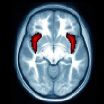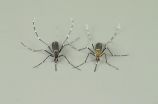(Press-News.org) U.S. Army soldiers hospitalized with a psychiatric disorder have a significantly elevated suicide risk in the year following discharge from the hospital, according to research from the Army Study to Assess Risk and Resilience in Servicemembers (Army STARRS). The yearly suicide rate for this group, 263.9 per 100,000 soldiers, was far higher than the rate of 18.5 suicides per 100,000 in the Regular Army for the same study period, the study found.
The researchers looked at data from the 12 months following a hospital discharge for more than 40,000 anonymous, Regular Army soldiers (full-time soldiers excluding Army National Guard and Army Reserve) who served on active duty from 2004 through 2009.
Ronald C. Kessler, Ph.D., of the Harvard Medical School in Boston, and colleagues, report their findings on Nov. 12, in JAMA Psychiatry. Army STARRS is a partnership between the Army and the National Institute of Mental Health (NIMH), part of the National Institutes of Health.
The Army's suicide rate began increasing in 2004, exceeded the rate among a similar group of U.S. civilians in 2009, and has remained high through 2014. This study of administrative data shows that 40,820 soldiers (0.8 percent of all Regular Army soldiers) were hospitalized with a psychiatric disorder in 2004-2009, the period covered by this research. Suicides occurring in this group during the year after a hospital discharge accounted for 12 percent of all Regular Army suicides during this period.
Researchers also found that it was possible to identify smaller, higher-risk groups within this at-risk population. Analyzing soldiers' characteristics and experiences, researchers identified the 5 percent of soldiers with the highest predicted risk of suicide after leaving the hospital. This top 5 percent accounted for 52.9 percent of the post-hospital suicides. Soldiers in the top 5 percent also accounted for a greater proportion of accident deaths, suicide attempts, and re-hospitalizations.
The researchers report that, for this group of hospitalized soldiers, some of the strongest predictors of suicide include being male, having enlisted at an older age, having a history of criminal offenses during Army service, having had prior suicidal thoughts or actions, as well as disorders diagnosed during hospitalization and aspects of prior psychiatric treatment. However, researchers found that many factors contributed toward predicting suicide risk in this group, individually and in combination. This fact underscores the complexity of assessing suicide risk and the added value of developing new approaches to better predict very challenging events.
"This is the first publication from Army STARRS that reports on the ability to use Army/Department of Defense data to identify specific subgroups within the Army that have very significantly elevated suicide risk," said NIMH Director Thomas R. Insel, M.D. "However, there are sensitivities to using data to identify high-risk subgroups. It's important to remember that although a particular population may be at elevated risk, suicide remains a rare event."
Researchers concluded that the high concentration of suicide risk among this study group, and particularly in the smaller highest-risk groups, might justify targeting expanded post-hospital interventions for such people. Researchers continue to develop and refine computer models to help the Army predict suicide risk among soldiers and prevent self-harm.
INFORMATION:
Reference
Kessler RC, Warner CH, Ivany C, Petukhova MV, Rose S, Bromet EJ, Brown M, Cai T, Colpe LJ, Cox KL, Fullerton CS, Gilman SE, Gruber MJ, Heeringa SG, Lewandowski-Romps L, Li J, Millikan-Bell AM, Naifeh JA, Nock MK, Rosellini AJ, Sampson NA, Schoenbaum M, Stein MB, Wessly S, Zaslavsky AM, Ursano RJ. Predicting U.S. Army suicides after hospitalizations with psychiatric diagnoses in the Army Study to Assess Risk and Resilience in Servicemembers, JAMA Psychiatry, November 12, 2014
About Army STARRS
The Army Study to Assess Risk and Resilience in Servicemembers (Army STARRS) is funded by the U.S. Army and the National Institute of Mental Health. The study is led by co-principal investigators Robert J. Ursano, M.D. (Uniformed Services University of the Health Sciences), and Murray B. Stein, M.D., M.P.H. (University of California, San Diego), with site investigators Steven G. Heeringa, Ph.D. (University of Michigan), and Ronald C. Kessler, Ph.D. (Harvard Medical School), and with collaborating scientists Lisa J. Colpe, Ph.D., M.P.H. (NIMH), and Michael Schoenbaum, Ph.D. (NIMH). Contact us at http://www.armystarrs.org/media_room
About the National Institute of Mental Health (NIMH)
The mission of the NIMH is to transform the understanding and treatment of mental illnesses through basic and clinical research, paving the way for prevention, recovery, and cure. For more information, visit http://www.nimh.nih.gov.
About the National Institutes of Health (NIH)
NIH, the Nation's medical research agency, includes 27 Institutes and Centers and is a component of the U.S. Department of Health and Human Services. NIH is the primary federal agency conducting and supporting basic, clinical, and translational medical research, and is investigating the causes, treatments, and cures for both common and rare diseases. For more information about NIH and its programs, visit http://www.nih.gov.
It has long been known that patients recently discharged from psychiatric hospitalizations have a significantly elevated suicide risk. However, the rarity of suicide even in this high-risk segment of the population makes it impractical to justify providing intensive post-hospital suicide prevention programs to all recently discharged patients. Targeted programs for patients at especially high suicide risk would be more feasible, but it is difficult for clinicians to predict with good accuracy which patients are at high risk for suicide.
A new report published online today ...
Nearly a quarter of all patients who underwent initial breast conservation surgery (BCS) for breast cancer had a subsequent surgical intervention, according to a report published online by JAMA Surgery.
Completely removing breast cancer is seen as the best way to reduce recurrence and improve survival. A lack of consensus on an adequate margin width has led to variable rates of reexcision and, as a result, patients undergo repeat or additional surgeries, according to background information provided in the study.
Lee G. Wilke, M.D., of the University of Wisconsin School ...
A study that looked at predicting suicides in U.S. Army soldiers after they are hospitalized for a psychiatric disorder suggests that nearly 53 percent of posthospitalization suicides occurred following the 5 percent of hospitalizations with the highest predicted suicide risk, according to a report in JAMA Psychiatry.
The suicide rate in the U.S. Army has increased since 2004 and now exceeds the rate among civilians. Still, suicide is a rare outcome even among recently discharged psychiatric patients. A potentially promising approach to assess posthospitalization suicide ...
SEATTLE - Preterm birth is now the leading cause of death for children under 5 worldwide, and a new scientific paper reveals a startling lack of knowledge about what causes it and how to prevent it.
Published in the November issue of Science Translational Medicine, "Prevention of Preterm Birth: Harnessing Science to Address the Global Epidemic" shines a light on the urgent need for a larger, coordinated research effort to discover how to identify women at risk of preterm birth and develop prevention interventions.
"There are not enough resources dedicated to researching ...
Older women with disordered breathing during sleep were found to be at greater risk of decline in the ability to perform daily activities, such as grocery shopping and meal preparation, according to a new study led by researchers at the Johns Hopkins Bloomberg School of Public Health and the University of California, San Francisco.
The study was published Nov. 6 in the online edition of the Journal of the American Geriatrics Society.
The findings are notable given the aging of the population - an estimated 3.7 million Americans will turn 65 in 2015, and by 2030, 19 ...
In school-age children previously diagnosed with depression as preschoolers, a key brain region involved in emotion is smaller than in their peers who were not depressed, scientists have shown.
The research, by a team at Washington University School of Medicine in St. Louis, also suggests that the size of the brain's right anterior insula may predict the risk of future bouts of depression, potentially giving researchers an anatomical marker to identify those at high risk for recurrence.
The study is published online Nov. 12 in the journal JAMA Psychiatry.
There is ...
One of the world's deadliest mosquitoes sustains its taste for human blood thanks in part to a genetic tweak that makes it more sensitive to human odor, according to new research.
Researchers report in the journal Nature that the yellow fever mosquito contains a version of an odor-detecting gene in its antennae that is highly attuned to sulcatone, a compound prevalent in human odor. The researchers found that the gene, AaegOr4, is more abundant and more sensitive in the human-preferring "domestic" form of the yellow fever mosquito than in its ancestral "forest" form that ...
Adding tiny amounts of vegetable puree to milk and then rice at the time of weaning makes children more likely to eat vegetables, new University of Leeds research shows.
Infants who consumed either milk (breast milk or formula) followed by rice mixed with vegetable puree ate nearly half as many vegetables again as infants who ate just milk followed by baby rice.
Professor Marion Hetherington, of the School of Psychology at the University of Leeds, led the study. She said: "We took inspiration from French mothers, as previous studies in this area have shown that they ...
(SACRAMENTO, Calif.) -- In its first clinical application in pediatric patients, an investigational medication developed and manufactured at UC Davis has been found to effectively treat children with life-threatening and difficult-to-control epileptic seizures without side effects, according to a research report by scientists at UC Davis and Northwestern University.
The investigational formulation of allopregnanolone was manufactured by UC Davis Health System's Good Manufacturing Practice Laboratory. Two children were treated with the allopregnanolone formulation, one ...
LA JOLLA, CA - November 12, 2014 - Driving to work becomes routine--but could you drive the entire way in reverse gear? Humans, like many animals, are accustomed to seeing objects pass behind us as we go forward. Moving backwards feels unnatural.
In a new study, scientists from The Scripps Research Institute (TSRI) reveal that moving forward actually trains the brain to perceive the world normally. The findings also show that the relationship between neurons in the eye and the brain is more complicated than previously thought--in fact, the order in which we see things ...


